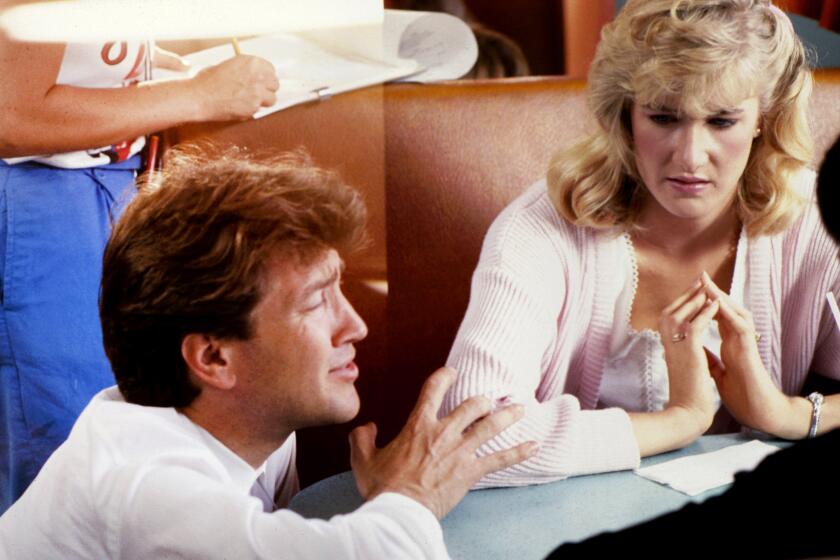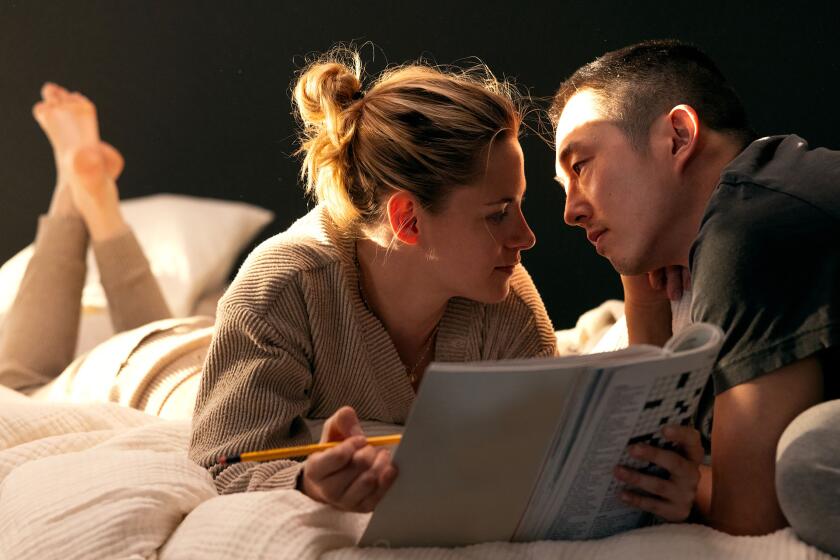Flashing Back to 1967’s ‘Chappaqua’
- Share via
Filmgoers have been invited this year to celebrate the anniversaries of such seminal films as “Star Wars,” “The Godfather” and “The Graduate.”
To this august company, now add “Chappaqua.” Thirty years after its limited theatrical release, this relic of 1960s underground cinema has been unearthed for home video.
Chappa-what? That was author William Burroughs’ reaction when Conrad Rooks, the independent film’s writer, director and star, asked him to be in it. “That’s not a very good title,” Burroughs recalled telling Rooks. “People won’t know what the film is about. Conrad said, ‘They will after they see it.’ I said, ‘Well, they won’t see it with that title.’ ”
“Chappaqua” is a semiautobiographical “diary” of a young addict’s sleep-cure at a Paris clinic. A kaleidoscope of psychedelic and surreal imagery, running the gamut from quadruple exposures to footage of an actual Indian peyote ceremony, dramatizes his nightmarish and torturous withdrawal from alcohol and drug addiction. According to Rooks, the title is an American Indian word that means “source” and is also the name of the New York suburb where he spent “an idyllic childhood.”
Look “Chappaqua” up in Leonard Maltin’s “Movie and Video Guide” and you’ll find a dismissive two-star rating, but it was more enthusiastically received in 1967.
It was awarded the Silver Lion at the Venice Film Festival. Newsweek called it a “mind-blowing movie biography.” Newsday cited it as “one of the year’s most serious, memorable and important movies.” Writing in The Times, Charles Champlin called it “intriguing and tedious, beautiful and instructive yet disturbing in a way it was not intended to be.”
Michael Olivieri, president of New York-based Fox Lorber Home Video, which specializes in independent and foreign films, says the film “has some good credentials. Thirty years later it’s an interesting look at experimental filmmaking of the 1960s, a piece of cultural history.”
Rooks, speaking by phone from his home in Thailand, where he has lived since leaving India in 1984, calls it “a fluke, but an interesting fluke.” That it is, and especially for those interested in Beat culture. Perhaps what is most compelling about “Chappaqua” is its credits, which comprise a hipster hall of fame.
In addition to Burroughs, who appears as Opium Jones, the film briefly features poet Allen Ginsberg, who died in April, chanting blissfully in New York’s Central Park. Rooks’ cameraman was venerable photographer Robert Frank, director of “Pull My Daisy,” whose books include “The Americans.”
The musical score was composed and is performed by Ravi Shankar. Phil (as in Philip) Glass, at the time a student who had transcribed music for Shankar, is given a consultant credit. The soundtrack also includes cult rockers the Fugs and jazz saxophonist Ornette Coleman.
Initially largely financed by Rooks, the son of a cosmetics tycoon, “Chappaqua” was made in fits and starts over three years for about $800,000. The film, he said, owes its sensibilities to the Beat poets and writers with whom Rooks seemed to have had Kevin Bacon-like associations.
“Many people who have seen the film think it’s phony,” Rooks said, “and that’s not true. This is a loose fantasy built around this particular treatment I went through in Zurich.
“Doing a Hollywood number, another ‘Man With the Golden Arm,’ certainly wasn’t in keeping with the counterculture, as it is now called. Basically, the Beats were against hypocrisy of any kind. So I guess that’s what I was really lashing out at.”
“Chappaqua” had its genesis in a poem that Rooks wrote and sent to Ginsberg, whom he met through his first wife when the couple lived on Bleeker Street in New York’s Greenwich Village. “Allen was a mentor,” Rooks said. “I think the most outstanding thing, aside from his talent as a poet, was his kindness. He wrote me back a four-page critique [of the poem]. Even though we knew each other socially, it was a big boost that he would bother to reply.”
The film’s structure, such as it is, most reflects the influence of Burroughs, whom Rooks met in Paris. He adopted Burroughs’ “fold-in” method of writing, by which a page of text was folded and combined with another. “Due to some synchronicity,” Rooks said, “certain words would jump off the page and he would lift them out and rearrange them. I felt that would lend itself perfectly to the kind of structure that was evolving with the film.”
Rooks, 62, made only one other film, “Siddhartha,” in 1972, after which he “started over.” He moved to India to distribute the film himself. He married an Indian woman with whom he had a son. He moved to Thailand, he said, after their breakup.
“I had spent so much time in India and Europe that I found it hard to adjust to living in Los Angeles. It would have been much wiser [from a career standpoint] to move there,” he said, “but my life didn’t turn out like that.”
Lately, he said, “I’ve spent an awful lot of time trying to figure out the computer. Once you get involved with the Net, you can lose a great deal of time.”
Rooks has accompanied “Chappaqua” on the film festival circuit. Seeing the film again, he said, “is pretty annoying. Generally, I walk out. It’s pretty difficult imagining that’s how nutty I was.”
Does the renewed attention signal a reentry into filmmaking?
“I could conceivably do another film,” he said. “But I’m not going to put my money in it. Or maybe this will give me the opportunity to write a book about the two films. If that happens, that’s OK too.”
More to Read
Only good movies
Get the Indie Focus newsletter, Mark Olsen's weekly guide to the world of cinema.
You may occasionally receive promotional content from the Los Angeles Times.










